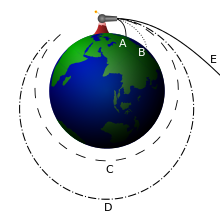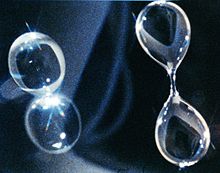weightlessness
Weightlessness describes a state in which the weight on a body cannot be felt. He then does not press on a surface - there is no counterforce . The state of near weightlessness is called microgravity .
In general, a body is in a weightless state when gravity can set it in accelerated motion without being hindered by a counterforce . Such states exist to a good approximation in free fall - for example in a drop tower - in non-powered flight in space or in parabolic flight . Weightlessness applies approximately equally to all components of an unhindered accelerated body. Therefore an object that is released by an astronaut in the ISS floats freely next to it in space: The ISS, the astronaut and the object experience practically the same acceleration in their free "fall" around the earth in the earth's gravitational field.
Complete, exact weightlessness would only be possible in a spatially constant gravitational field, which does not exist, or for a point-like body. Due to its expansion, a real body is not subject to the same gravitational acceleration in all of its parts, which becomes noticeable as tidal force or microgravity during free fall .
Overview

The effect of gravity on the earth can be seen e.g. For example, when an apple falls from the tree to the ground or we are pressed to the ground with our weight. The heaviness acts in the whole body and on each of its parts, it shows itself as volume force . What we feel as heaviness and usually equate it with gravity is based on the fact that the ground exerts a counterforce from below. However, this does not have the same effect in all parts of our body, but rather on our feet, which have to carry our full weight, much weaker on the neck, which only supports the head. Therefore our body is compressed a little.
The easiest way to achieve weightlessness, at least for a limited time, is free fall. For a completely free fall, the braking influence of the air must be switched off, which is possible in evacuated drop towers .
Every body thrown vertically, obliquely or horizontally or in general every body on a trajectory parabola (without any further force, i.e. especially without air friction) is weightless. In so-called parabolic flights , up to 90 seconds of weightlessness are achieved, during which the air friction on the aircraft is compensated for by the thrust of the engines or suitable flight maneuvers. Parabolic flights were originally intended for weightlessness training for astronauts , but are now mainly used for scientific experiments in microgravity (e.g. materials science or cell biology ) and for testing space technologies. There are commercial parabolic flights in various countries.
Examples of (approximate) weightlessness in everyday life
- When jumping on a trampoline from a height of 1.5 meters, the feeling of "weightlessness" can be experienced for more than a second.
- If a vessel is thrown a few meters, the objects in it behave almost weightlessly with one another . Examples: a large, empty plastic water bottle with a few nuts or marbles thrown in it; a cube made of plexiglass with objects placed in it; a glass balloon with water that is shaken vigorously so that you can observe the air bubbles as they are thrown.
- Even when high diving or bungee jumping , the jumper's body feels weightless (even if only for a few seconds) until the water surface is touched or the elastic rope tightens. When jumping from a great height, for example with a parachute , the feeling of weightlessness ends after a few seconds, as the air resistance is then clearly noticeable.
- Seconds of weightlessness can also be experienced in various rides in amusement parks , especially roller coasters and free-fall towers . In fan jargon it is called airtime there.
In underwater simulations, such as those carried out for training purposes for astronauts, there is no real weightlessness or “counterforce”: only gravity is compensated by the static buoyancy in the water. The astronaut floats in the water, but the opposing force also acts on his body from the outside as a surface force . Therefore, you don't have the same feeling in the water as in free fall, but rather you feel carried by the water.
(Approximate) weightlessness in orbit
So far, terrestrial space travelers have only left the immediate vicinity of Earth in a few Apollo moon missions. All other astronauts orbit about 500 km above the earth's surface. In a near-earth orbit, which is typical for manned space travel , one is constantly in weightlessness. Although around 90% of Earth's gravity is still at work at the altitude at which a space station is usually located, astronauts cannot feel it - precisely because gravity accelerates all masses, including astronauts, evenly and no other forces act.
The weightlessness that can be achieved there is not perfect, the effects of gravity are still slightly noticeable:
- The strength of the earth's gravitational field is inhomogeneous, i.e. This means that with increasing distance from the earth it decreases by one millionth for every three meters (this rule of thumb applies to the area close to the earth up to a few hundred kilometers in altitude). Therefore, the difference in gravity within the spacecraft volume is already in the measurable range.
- The more distant part of a body in orbit experiences a greater centrifugal force than the part closer to the earth.
- At the height of the orbit the atmosphere is very thin, but there is still air there, the air resistance of which causes the spaceship to be slowed down by friction. This causes a forward-directed force on space travelers , as the deceleration is not compensated by a permanently running small engine, but only in bursts.
The tidal force on a body in the spaceship, which is caused by the first two points, is directed away from the earth when the body is above the center of gravity of the spaceship, in the rest of the spaceship it acts downwards towards the earth. So in the long run everything falls on the upper or lower wall of the spaceship.
- People in weightlessness
On board the ISS : Michael Foale trains on the treadmill that hangs from the "ceiling"
Weightless astronaut in low earth orbit
Weightlessness during a parabolic flight in a Boeing C-135
Effects of microgravity
Weightlessness can cause problems with sensitive technical devices (especially those with numerous moving parts). Physical processes that depend on the effect of the weight of bodies (such as convection , see for example candles or boiling water ) work just as little in a weightless state as some everyday devices such as e.g. B. showers , sinks or toilets . Therefore, in space shuttles and space stations specially adapted sanitary facilities (e.g. a toilet with a faecal suction system) are used. In space people do not drink from cups or glasses, but from closable tubes or mugs with lids and closable straws.
The human body often reacts to the feeling of weightlessness with space sickness , which, like motion sickness, is caused by a confusion of the sense of balance .
As you get used to the weightless state, the symptoms characteristic of space sickness disappear (dizziness, nausea and even vomiting). Prolonged weightlessness (two months or more) leads to an adaptation of the human body to the relief (especially noticeable in the spinal column and leg area): bone and muscle mass as well as blood volume dwindle, which causes health problems for many space travelers when they return to earth prepares. As a preventive measure, astronauts on long-term missions (on a treadmill or ergometer ) have to use physical exercise to counter weightlessness with an artificially generated resistance. In 2012, studies on astronauts also showed changes in the brain and eyes.
Freefall experiments in (almost) weightlessness
Weightlessness offers special research conditions. For example, the adhesive force and the surface tension properties can be better observed. Their interplay leads to the fact that a water column (fountain, small waterfall) is deformed like a chain, even in everyday life with freely falling liquids, because the surface tension tries to form spherical drops, while cohesion tries to hold the water column together.
- The 146 meter high drop tower in Bremen enables a drop height of 110 m in an evacuated pipe with a diameter of 3.5 m. Nevertheless, the fall time is still relatively short at this great height of fall, it is around 4.7 seconds. The experiments are carried out in a specially constructed drop capsule , which is slowed down at the end of the drop section in an 8 m high container filled with fine-grain polystyrene granulate. There the "test candidates" have a top speed of 167 km / h. Since 2004 the tower has also had a catapult with which the drop capsule can be shot up. The experiment then experiences weightlessness for about 9.2 seconds, since the climb is already a "free fall".
- The 40 meter high Einstein Elevator at the Hannover Institute for Technology (HITec) at Leibniz University Hannover has a fall distance of 20 m for free ascent and descent and enables up to 100 tests per day with four seconds of weightlessness.
- A “mini fall tower” about two meters high allows a fall time of 0.6 seconds, which is sufficient for observation and evaluation using a video signal and computer.
- An old use of drop towers is to make shotgun pellets. Liquid lead is allowed to rain down inside a scrap tower through a fine sieve. During the free fall, the lead drops take on the round spherical shape.
Web links
Individual evidence
- ↑ The gravity is by far the largest share of the weight force . It also remains effective “in weightlessness”, as can be seen from the acceleration due to gravity . Therefore, some authors consider the term weightlessness to be extremely misleading and prefer no counterforce . Please refer. u. a .: Ludwig Bergmann, Clemens Schaefer: Textbook of Experimental Physics. Mechanics, relativity, warmth. Volume 1, p. 162 f. de Gruyter, 1998, ISBN 3-11-012870-5 ( limited preview in Google book search). .
- ↑ Cell functions in microgravity , University of Magdeburg
- ↑ Glass balloon experiment in episode 11 "People Without Weight" of the series What are people looking for in space? with Heinz Haber .
- ↑ Weightlessness changes the brain. On: orf.at. March 13, 2012, accessed October 31, 2014.
- ↑ Astronauts' eyeballs deformed by long missions in space, study finds. On: guardian.co.uk. March 13, 2012, accessed October 31, 2014.
- ↑ Larry A. Kramer et al. a .: Orbital and Intracranial Effects of Microgravity: Findings at 3-T MR Imaging. On: pubs.rsna.org. June 2012, accessed October 31, 2014.
- ↑ Center for Applied Space Technology and Microgravity








